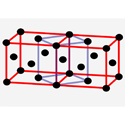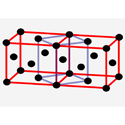No strain, no gain
Materials that have a magnetic or electronic response to stretching or compressing their crystal structures are the basis of many sensors and actuators. Yet actually freezing the deformation of a crystal lattice, say by growing the material on top of a seed surface (epitaxial growth), is limited to extremely thin films, because thicker films tend to relax back to their natural structure.
Now, Jörg Buschbeck and colleagues at the IFW in Dresden, the Dresden University of Technology, the Universität Frankfurt, and the Johannes Gutenberg-Universität Mainz, Germany, have taken advantage of the structurally soft properties of a magnetic shape memory alloy to grow epitaxial films with a range of magnetic properties. Writing in Physical Review Letters, they report the growth and characterization of - -thick films of an iron-palladium alloy that span a variation in tetragonal distortion (the ratio of the out-of-plane to in-plane lattice constants). This covers most of what is called the Bain transformation path between face-centered-cubic and body-centered-cubic crystal structures.
Buschbeck et al. grow the alloy films on top of a magnesium oxide surface, with a series of different metals acting as a buffer between the film and substrate. Depending on the buffer layer, the alloy will grow with different out-of-plane lattice constants. By tuning this structural distortion, they are able to change the magnetic transition temperature in the films by roughly , in addition to inducing a large variation in their magnetocrystalline anisotropy. The same growth method could be extended to making other functional materials, provided they have a similar structural instability. – Jessica Thomas





